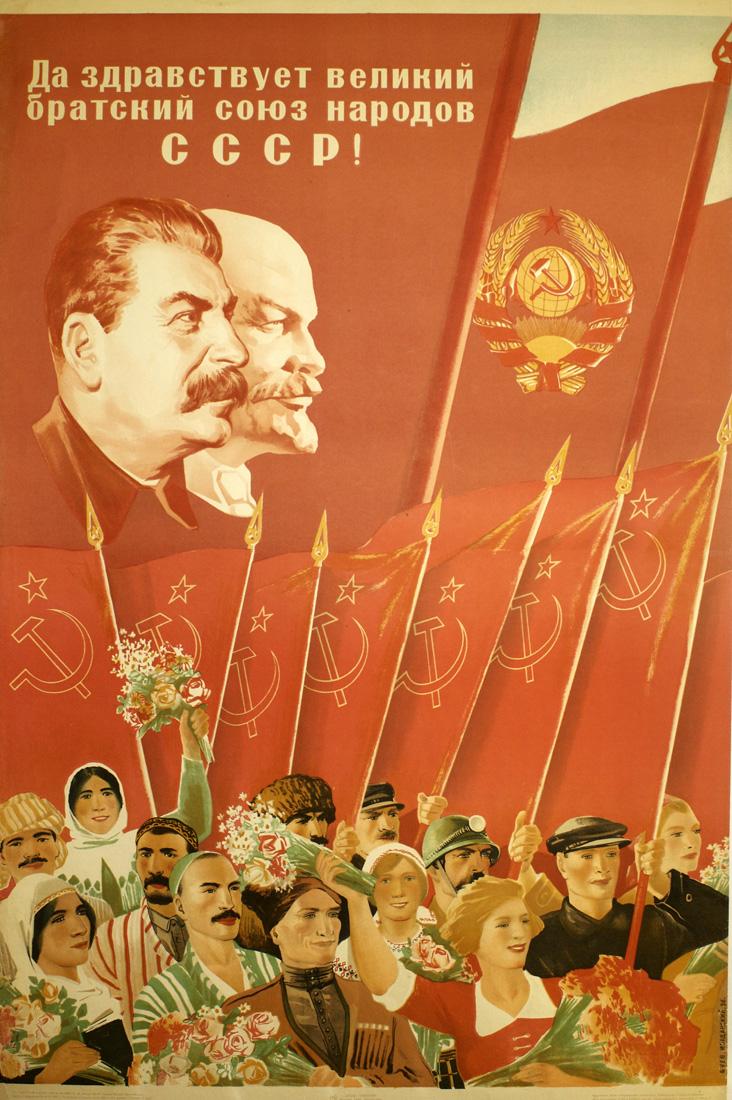
¡Viva el gran vínculo fraternal entre todas naciones de la URSS!
Número de Cartel: PP 159
Tamaño: 43.5x30.5
Tipo de cartel: Litografía
Fecha de publicación: 1936
Editores: Editor E. Povolotskaia; Technical Editor I. Kabanov
Información técnica: Izogiz No. 8380; I 32; Submitted for production April 8, 1936 [and] approved for printing September 21, 1936; Standard format 73 x 104; Volume 1 sheet of paper; Order No. 677; Price 80 kopeks; [Printed at] 3 Mir Street
Ediciones: 100,000
Número de Glavlit: B-27204
En el catologo: PP 159 Workers b
Artista: Buev, Ivan Petrovich — Буев, Иван Петрович
Ivan Buev is chiefly known as a painter and a graphic artist and yet he also worked in the monumental and applied art fields. During the 1920s, he studied at VKhUTEIN (Higher State Artistic and Technical Institute), Moscow. In partnership with Boris Iordanskii, Buev worked on the Soviet pavilion for the International Exposition of Art and Technology in Modern Life in Paris (Paris Expo) held from 1936-1937. During the 1930s, Buev was engaged in the ...
Leer más...
Artista: Iordanskii, Boris Viacheslavovich — Иорданский, Борис Вячеславович
Boris Viacheslavovich Iordanskii studied at VKhUTEMAS-VKhUTEIN (Higher Art and Technical Institute) in Moscow from 1922 to 1930. He was a member of A.Kh.R. (Association of Artists of the Revolution) from 1928 to 1931 and a member of RAPKh (Association of Soviet Artists) in Moscow from 1931 to 1932. Iordanskii is known primarily for his paintings and monumental art designs but he also worked in the genre of graphic arts (i.e. posters) during his career. As an instructor of ...
Leer más...
Imprenta: 24th Lithography Workshop of the Poligrafkniga Trust of Ogiz, Leningrad — 24-я типография ОГИЗа РСФСР треста Полиграфкнига, Ленинград
The 24th Lithography Workshop was located at Kronverkskaia and Mir Streets in Leningrad (St. Petersburg). Historically, the workshop had its roots in Imperial Russia and it was a large printing operation founded in 1881 by Theodore Kibbel (a.k.a. Fedor Fyodorovich Kibbel). Shortly after the printer was nationalized by the Soviets, it became the 1st State Lithography Workshop. In 1924, the workshop was named in honor of Mikhail Pavlovich Tomskii (1880-1936), head of the Soviet trade ...
Leer más...
Editorial: Ogiz-IzoGiz, Moscow-Leningrad — Огиз-Изогиз, Москва-Ленинград
Ogiz was the Association of the State Book and Magazine Publishers. Its main offices were located in Moscow and in Leningrad. The Sovnarkom of the Russian Socialist Federative Soviet Republic established Ogiz in 1930 to centralize publishing activities under a state monopoly in order to eliminate duplication of printed material, streamline and control publishing production and output, and to create a base for marketing books, training and technical manuals. In 1931, the Central Committee of the USSR ...
Leer más...